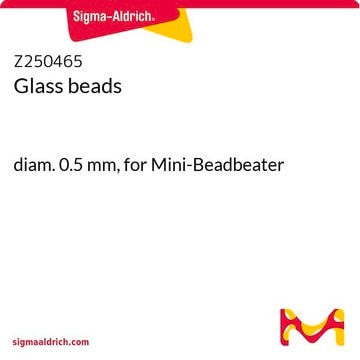18406
Glass beads
diam. ~5 mm
Synonym(s):
Glass beads, Anti-bumping granules
Sign Into View Organizational & Contract Pricing
All Photos(1)
About This Item
UNSPSC Code:
12352103
NACRES:
NA.22
Recommended Products
diam.
~5 mm
Quality Level
Looking for similar products? Visit Product Comparison Guide
General description
Glass beads ~5 mm are made of high purity soda-lime glass.
Application
Glass beads are generally added to the boiling solutions to prevent bumping. It is also used as supports to various photocatalysts to enhance the adsorption of organic pollutants in photocatalysis.
Storage Class Code
11 - Combustible Solids
WGK
nwg
Flash Point(F)
Not applicable
Flash Point(C)
Not applicable
Personal Protective Equipment
dust mask type N95 (US), Eyeshields, Gloves
Choose from one of the most recent versions:
Already Own This Product?
Find documentation for the products that you have recently purchased in the Document Library.
Customers Also Viewed
Effect of adsorbents coated with titanium dioxide on the photocatalytic degradation of propoxur.
Lu MC, et al.
Chemosphere, 38(3), 617-627 (1999)
Josef Wagner et al.
PloS one, 3(10), e3578-e3578 (2008-11-01)
Molecular analysis of bacterial 16S rRNA genes has made a significant contribution to the identification and characterisation of bacterial flora in the human gut. In particular, this methodology has helped characterise bacterial families implicated in the aetiology of inflammatory bowel
Syed Zafar Sultan et al.
FEMS microbiology letters, 302(1), 22-31 (2009-11-17)
The PhoBR regulatory system is required for the induction of multiple genes under conditions of phosphate limitation. Here, we examine the role of PhoB in biofilm formation and environmental stress response in Vibrio cholerae of the El Tor biotype. Deletion
Asier González et al.
Molecular and cellular biology, 29(10), 2876-2888 (2009-03-11)
Yeast ptc1 mutants are rapamycin and caffeine sensitive, suggesting a functional connection between Ptc1 and the TOR pathway that is not shared by most members of the type 2C phosphatase family. Genome-wide profiling revealed that the ptc1 mutation largely attenuates
The polyhydric alcohol-polybasic acid reaction. I. Glycerol-phthalic anhydride.
Kienle RH and Hovey AG
Journal of the American Chemical Society, 51(2), 509-519 (1929)
Our team of scientists has experience in all areas of research including Life Science, Material Science, Chemical Synthesis, Chromatography, Analytical and many others.
Contact Technical Service





